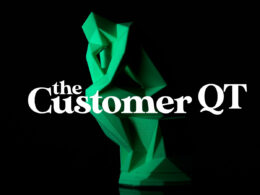He says he’s going to make JCPenney an exciting destination again. I’m not sure he wasn’t being ironic.
So this guy says, “I get my best ideas on my morning run. It was one of those runs where I hit on the new idea of selling existing customers more, rather than trying to attract new shoppers.”
Surprising? Well, not so much. Exercise increases blood flow, so you get more energy and oxygen, which revs up neurons, and your brain functions at a higher level. But wait! There’s more! Washing off the sweat from that run also helps. A study showed 79% percent of people report more inspiration in the shower, to relax and allow the dopamine high from a run to settle in. Cool!
But nothing is always true. More specifically, not at all true when it comes to that guy’s statement about getting his best, new idea on his morning run. Because it wasn’t! Best? C’mon, man not even close! Unoriginal? Absolutely. Pedestrian? Unquestionably. On the upside, it was self-evident. Selling to existing customers is not a new idea. It’s called “customer loyalty,” and it’s kind of a brand prime-directive. A retail raison d’etre. A marketing mandate. The prophet of profit. OK, I’m done. You get the point.
Our years of research into loyalty have shown loyal customers spend nearly 37% more compared to new customers. There are other proofs of concept for concentrating on loyalty, but that’s for another time. This one is about the guy who thought it was his best idea. Marc Rosen, JCPenney’s new CEO, who’s not trying to win new, younger, or online customers. He’s the 6th JCPenney CEO in 17 years. But no surprise there.
Mike Ullman was JCPenney’s CEO from 2004 to 2011 and again in 2013 till 2015. He eliminated their catalog. Ron Johnson was CEO from 2011 to 2013. He launched expensive store renovations and eliminated coupons. Marvin Ellison was CEO 2015 to 2018 and focused on appliances. Jill Soltau was brought in in 2018, stopped selling appliances, revamped store layouts again, and focused on apparel. She walked (or was walked out) in December 2020.
Mr. Rosen, hired in 2021, says he’s focusing on customers who already shop there, which, alas, is a rapidly dwindling pool. He says he’s going to make JCPenney an exciting destination again. I’m not sure he wasn’t being ironic. He says he’s going to put in new lights! If any of this sounds like déjà vu all over again, it’s because Mike, Ron, Mike (again), Marvin, and Jill all tried stuff like that. None of it stopped customer hemorrhaging or fortified brand engagement. OK, in fairness they didn’t try all that stuff all at once, but still. So, here’s a question for you. Is the problem with the brand or the CEO or a both? You know, a kind of reverse synergy. Here are some basic facts to help you decide.
Average CEO tenure is 6.9 years. JCPenney’s has been 2.8 years if you include their Chapter 11 gap year between Jill and Marc. 2.3 years if you don’t. What does that say about who they hire? I searched and searched, but believe it or not, I could not find any list of “Toughest Jobs In America” that included “JCPenney CEO.”
When it comes to loyal customers, JCPenney hasn’t been in the top-5 for Department Store loyalty in our Customer Loyalty Engagement Index in, well, forever. And we’ve been doing that study for 25 years! QED, no loyal customers, no sales, no profits. Sorry, that’s just reality. As is the brand’s inability to recognize, let alone meet, customers ever-increasing expectations in their category.
Ultimately everything comes down to the bottom line, so let’s look at it. JCPenney hasn’t turned a profit since 2010. Annual sales have fallen every year since 2016. They lost $1.3 billion in the first 10 months of 2020 with a 10.2% drop in overall sales during the holidays. Online sales grew 3.3%. But to put that into perspective, average ecommerce growth runs about 15%. Store visits were
-31% over the past two years. They’re shuttering a third of its remaining sites and fired another 650 employees. New lights? Not going to help!
JCPenney’s new owners (Simon and Brookfield Asset Management, U.S. mall operators, bought JCPenney out of bankruptcy last year) say, “It’s a work in progress.” But it’s more like a brand mired in the past. Or maybe in retreat. But again (and again and again and again and again) it’s come down to the CEO being unable to understand customers’ mostly-emotional expectations and their inability to do something meaningful and engaging. Look, customers shop brands that best meet their expectations and JCPenney hasn’t and doesn’t. Shoppers need a compelling reason to buy from a brand, and not the competition, and JCPenney has none. Compelling reasons, I mean. They have plenty of competition!
Former customers’ shopping psyches have largely turned the brand off. Current customers, what few there are, are in the process of doing so. Knowing what shoppers really expect is a CEO’s job. But based on the folks they’ve brought in and what they’ve done, clearly they haven’t. From a brand perspective, customer engagement has fizzled. The CEOs haven’t had an idea of what the brand should be. Or could be. So, questions abound.
Discounter or department store? Price isn’t often the issue. There’s always someplace cheaper (read my last column and you’ll see “cheap” doesn’t make as much of a contribution to engagement and sales as CEO’s might wish). Customer service like curbside pick-up or buy-online-pickup-in-store? JCPenney’s physical plant and in-store functionality can’t accommodate those. Convenient locations? Nah. Aging malls without anchor stores have been left to drift and drown. Online? Not so much for JCPenney. Their platform is generations behind successful competitors.
What the brand needs is an injection of retail relevance. And a CEO with a fix on what today’s shoppers really expect.
Maybe a longer run and a colder shower would help.
 Robert Passikoff is founder and CEO of Brand Keys. He has received several awards for market research innovation including the prestigious Gold Ogilvy Award and is the author of 3 marketing and branding books including the best-seller, Predicting Market Success. Robert is also a frequent contributor to TheCustomer.
Robert Passikoff is founder and CEO of Brand Keys. He has received several awards for market research innovation including the prestigious Gold Ogilvy Award and is the author of 3 marketing and branding books including the best-seller, Predicting Market Success. Robert is also a frequent contributor to TheCustomer.
Photo by Raymond Kotewicz on Unsplash














2 comments